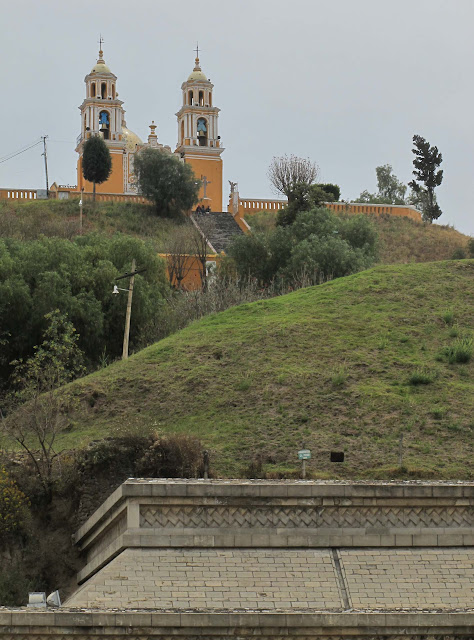The Valley of Puebla is a plain crossed by a number of small
rivers, streams and arroyos, with the most significant being the Atoyac
beginning with the runoff of the Iztaccíhuatl and Popocatepetl volcancos. Cholula, located in the river’s upper basin
at an altitude of about 2100 meters, is best known for its Great Pyramid, with
the Nuestra Señora de los Remedios sanctuary on top and its numerous churches.
Over the colonial period, forty-seven churches were constructed in the
city.
At first glance, the pyramid looks like a hill as most of it
is overgrown. The south side of the pyramid has been excavated and there is a
network of tunnels inside. From
the top of the pyramid, in the sanctuary atrium, it is possible to see the
Malinche, Popocatepetl, Iztaccíhuatl and Pico de Orizaba Volcanoes in the far
eastern horizon. The church was
built in 1594 and is home to an image of the Virgin of the Remedies, the patron
of Cholula. The first church collapsed in an earthquake in 1854 and was
rebuilt, damaged again by an earthquake in 1999 and repaired. The pyramid it is on was a pilgrimage
site in pre-Hispanic times, and it remains one now with people coming to visit
this Virgin image. According to myth, a giant named Xelhua, after he escaped a
flood in the neighboring Valley of Mexico, built the pyramid of adobe
bricks. Building of the pyramid
began in the pre Classic period and over time was built over six times to its
final dimensions of 18 meters tall and 120 meters (390 ft) on a side at the
base making it four times the size of the Great Pyramid of Giza and the largest
pyramid base in the Americas. In
the last state of construction, stairs on the west side led to a temple on top
facing Iztaccíhuatl. However, the
pyramid had been overgrown for centuries by the time the Spanish arrived. Exploration of the pyramid began in
1931 under architect Ignacio Marquina who dug tunnels to explore the
substructures.
One other important church of the San Andrés municipality is
the church of Santa María Tonantzintla, which is valued for its decoration in
what is called folk or indigenous baroque. The church was initially built in the 16th century and
developed over four phases until the 19th century. At the end of the 17th century, it had its basic layout, and
its intricate stucco work was begun and not completed until early 20th
century. These details include
pre-Hispanic elements such as dark skinned angels, niches with headdresses,
tropical fruits and ears of corn.
This area was originally sacred as Tonantzin, the mother goddess, the
Spanish replaced her with an image of the Virgin Mary.
The name of Cholula comes from the Nahuatl word
Cholōllān. Settlement of Cholula
began between about 500 BCE with the establishment of two small villages. At the end of the Pre-classic, many
other settlements in the area were abandoned but Cholula grew. This was the
time when work on the Great Pyramid began. Cholula continued to grow during the
Classic period to a population of about 25,000. In the Post-classic period, Cholula
grew to its largest size as a regionally dominant city. The city’s location was strategic, on
the trade routes between the Valley of Mexico, the Valley of Oaxaca and the
Gulf of Mexico, making it a major mercantile center. A variant of an artistic style and iconography, especially
in pottery, spread from Cholula to other areas in the Valley of Mexico, then to
other areas in Mesoamerica. This cultural trait is called Mixteca-Puebla was
spread by the vast trading networks that existed in Mesoamerica at that
time. By the time the Spanish
arrived, Cholula was a major religious and mercantile center and one of the
most important pilgrimage sites in the central Mexican highlands. Hernán Cortés estimated that the city
had 430 temples and a population of over 100,000. Cortés had arrived to Cholula after the Spanish victory of
the Tlaxcalans, and he was supposed to meet Moctezuma II here. Since Cholula
was allied with the Aztecs, the Spanish and their new Tlaxcalan allies were
suspicious of this. Cortés called
the leaders of the city to the central square of the city where the Spanish
charged and killed as many as six thousand Chololtecs. The event is called the
Cholula Massacre, and it resulted in destruction of much of the city. Unlike many other pre-Hispanic cities,
which were abandoned or destroyed before or immediately after the Conquest,
Cholula has remained to this day.
Nearby in the same valley the Spanish built the city of Puebla, which
grew to prominence rapidly.
Because of Puebla and an epidemic, which claimed much of its indigenous
population, Cholula never recovered its former importance. For more pictures please visit my picasa web album.
 |
| Pole Rain Dance |





No comments:
Post a Comment